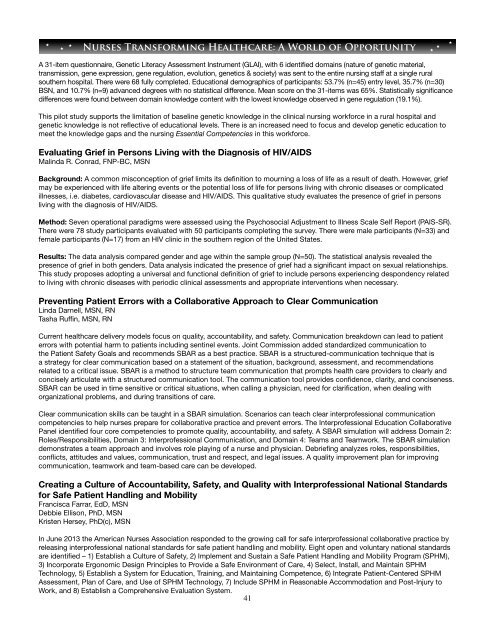2014 Tennessee Nurses Association Conference Yearbook
Create successful ePaper yourself
Turn your PDF publications into a flip-book with our unique Google optimized e-Paper software.
NURSES TRANSFORMING HEALTHCARE: A WORLD OF OPPORTUNITY<br />
A 31-item questionnaire, Genetic Literacy Assessment Instrument (GLAI), with 6 identified domains (nature of genetic material,<br />
transmission, gene expression, gene regulation, evolution, genetics & society) was sent to the entire nursing staff at a single rural<br />
southern hospital. There were 68 fully completed. Educational demographics of participants: 53.7% (n=45) entry level, 35.7% (n=30)<br />
BSN, and 10.7% (n=9) advanced degrees with no statistical difference. Mean score on the 31-items was 65%. Statistically significance<br />
differences were found between domain knowledge content with the lowest knowledge observed in gene regulation (19.1%).<br />
This pilot study supports the limitation of baseline genetic knowledge in the clinical nursing workforce in a rural hospital and<br />
genetic knowledge is not reflective of educational levels. There is an increased need to focus and develop genetic education to<br />
meet the knowledge gaps and the nursing Essential Competencies in this workforce.<br />
Evaluating Grief in Persons Living with the Diagnosis of HIV/AIDS<br />
Malinda R. Conrad, FNP-BC, MSN<br />
Background: A common misconception of grief limits its definition to mourning a loss of life as a result of death. However, grief<br />
may be experienced with life altering events or the potential loss of life for persons living with chronic diseases or complicated<br />
illnesses, i.e. diabetes, cardiovascular disease and HIV/AIDS. This qualitative study evaluates the presence of grief in persons<br />
living with the diagnosis of HIV/AIDS.<br />
Method: Seven operational paradigms were assessed using the Psychosocial Adjustment to Illness Scale Self Report (PAIS-SR).<br />
There were 78 study participants evaluated with 50 participants completing the survey. There were male participants (N=33) and<br />
female participants (N=17) from an HIV clinic in the southern region of the United States.<br />
Results: The data analysis compared gender and age within the sample group (N=50). The statistical analysis revealed the<br />
presence of grief in both genders. Data analysis indicated the presence of grief had a significant impact on sexual relationships.<br />
This study proposes adopting a universal and functional definition of grief to include persons experiencing despondency related<br />
to living with chronic diseases with periodic clinical assessments and appropriate interventions when necessary.<br />
Preventing Patient Errors with a Collaborative Approach to Clear Communication<br />
Linda Darnell, MSN, RN<br />
Tasha Ruffin, MSN, RN<br />
Current healthcare delivery models focus on quality, accountability, and safety. Communication breakdown can lead to patient<br />
errors with potential harm to patients including sentinel events. Joint Commission added standardized communication to<br />
the Patient Safety Goals and recommends SBAR as a best practice. SBAR is a structured-communication technique that is<br />
a strategy for clear communication based on a statement of the situation, background, assessment, and recommendations<br />
related to a critical issue. SBAR is a method to structure team communication that prompts health care providers to clearly and<br />
concisely articulate with a structured communication tool. The communication tool provides confidence, clarity, and conciseness.<br />
SBAR can be used in time sensitive or critical situations, when calling a physician, need for clarification, when dealing with<br />
organizational problems, and during transitions of care.<br />
Clear communication skills can be taught in a SBAR simulation. Scenarios can teach clear interprofessional communication<br />
competencies to help nurses prepare for collaborative practice and prevent errors. The Interprofessional Education Collaborative<br />
Panel identified four core competencies to promote quality, accountability, and safety. A SBAR simulation will address Domain 2:<br />
Roles/Responsibilities, Domain 3: Interprofessional Communication, and Domain 4: Teams and Teamwork. The SBAR simulation<br />
demonstrates a team approach and involves role playing of a nurse and physician. Debriefing analyzes roles, responsibilities,<br />
conflicts, attitudes and values, communication, trust and respect, and legal issues. A quality improvement plan for improving<br />
communication, teamwork and team-based care can be developed.<br />
Creating a Culture of Accountability, Safety, and Quality with Interprofessional National Standards<br />
for Safe Patient Handling and Mobility<br />
Francisca Farrar, EdD, MSN<br />
Debbie Ellison, PhD, MSN<br />
Kristen Hersey, PhD(c), MSN<br />
In June 2013 the American <strong>Nurses</strong> <strong>Association</strong> responded to the growing call for safe interprofessional collaborative practice by<br />
releasing interprofessional national standards for safe patient handling and mobility. Eight open and voluntary national standards<br />
are identified – 1) Establish a Culture of Safety, 2) Implement and Sustain a Safe Patient Handling and Mobility Program (SPHM),<br />
3) Incorporate Ergonomic Design Principles to Provide a Safe Environment of Care, 4) Select, Install, and Maintain SPHM<br />
Technology, 5) Establish a System for Education, Training, and Maintaining Competence, 6) Integrate Patient-Centered SPHM<br />
Assessment, Plan of Care, and Use of SPHM Technology, 7) Include SPHM in Reasonable Accommodation and Post-Injury to<br />
Work, and 8) Establish a Comprehensive Evaluation System.<br />
41

















